Vertex VX -2100, VX-2200 Service manual
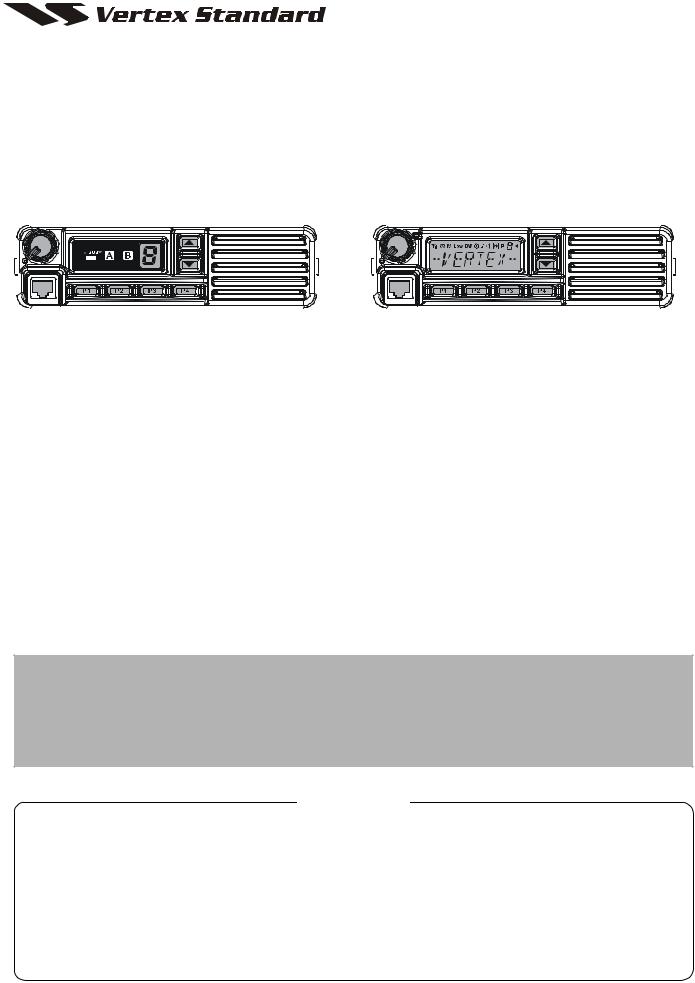
|
|
|
|
|
|
|
|
|
|
|
|
|
|
|
|
|
|
|
|
|
|
|
|
|
|
VERTEX STANDARD CO., LTD. |
|||||||||||||||
|
|
|
|
|
|
|
|
|
|
|
|
|
|
|
|
|
|
|
|
|
|
|
|
|
|
4-8-8 Nakameguro, Meguro-Ku, Tokyo 153-8644, Japan |
|||||||||||||||
|
|
VHF FM Transceiver |
|
|
|
|
VERTEX STANDARD |
||||||||||||||||||||||||||||||||||
|
|
|
|
|
|
US Headquarters |
|||||||||||||||||||||||||||||||||||
|
|
|
|
|
|
|
|
|
|
|
|
|
|
|
|
|
|
|
|
|
|
|
|
|
|
10900 Walker Street, Cypress, CA 90630, U.S.A. |
|||||||||||||||
|
|
VX-2100 Series |
|
|
|
|
YAESU EUROPE B.V. |
||||||||||||||||||||||||||||||||||
|
|
|
|
|
|
P.O. Box 75525, 1118 ZN Schiphol, The Netherlands |
|||||||||||||||||||||||||||||||||||
|
|
VX-2200 Series |
|
|
|
|
YAESU UK LTD. |
||||||||||||||||||||||||||||||||||
|
|
|
|
|
|
Unit 12, Sun Valley Business Park, Winnall Close |
|||||||||||||||||||||||||||||||||||
|
|
|
|
|
|
|
|
|
|
|
|
|
|
|
|
|
|
|
|
|
|
|
|
|
|
Winchester, Hampshire, SO23 0LB, U.K. |
|||||||||||||||
|
|
|
|
|
|
Service Manual |
|
|
|
|
VERTEX STANDARD HK LTD. |
||||||||||||||||||||||||||||||
|
|
|
|
|
|
|
|
|
|
Unit 5, 20/F., Seaview Centre, 139-141 Hoi Bun Road, |
|||||||||||||||||||||||||||||||
|
|
|
|
|
|
|
|
|
|
|
|
|
|
|
|
|
|
|
|
|
|
|
|
|
|
||||||||||||||||
©2006 VERTEX STANDARD CO., LTD. EC061N90A |
|
|
|
|
Kwun Tong, Kowloon, Hong Kong |
||||||||||||||||||||||||||||||||||||
|
|
|
|
|
|
|
|
|
|
|
|
|
|
|
|
|
|
|
|
||||||||||||||||||||||
|
|
|
|
|
|
|
|
|
|
|
|
|
|
|
|
|
|
|
|
|
|
|
|
|
|
|
|
|
|
|
|
|
|
|
|
|
|
|
|
|
|
|
|
|
|
|
|
|
|
|
|
|
|
|
|
|
|
|
|
|
|
|
|
|
|
|
|
|
|
|
|
|
|
|
|
|
|
|
|
|
|
|
|
|
|
|
|
|
|
|
|
|
|
|
|
|
|
|
|
|
|
|
|
|
|
|
|
|
|
|
|
|
|
|
|
|
|
|
|
|
|
|
|
|
|
|
|
|
|
|
|
|
|
|
|
|
|
|
|
|
|
|
|
|
|
|
|
|
|
|
|
|
|
|
|
|
|
|
|
|
|
|
|
|
|
|
|
|
|
|
|
|
|
|
|
|
|
|
|
|
|
|
|
|
|
|
|
|
|
|
|
|
|
|
|
|
|
|
|
|
|
|
|
|
|
|
|
|
|
|
|
|
|
|
|
|
|
|
|
|
|
|
|
|
|
|
|
|
|
|
|
|
|
|
|
|
|
|
|
|
|
|
|
|
|
|
|
|
|
|
|
|
|
|
|
|
|
|
|
|
|
|
|
|
|
|
|
|
|
|
|
|
|
|
|
|
|
|
|
|
|
|
|
|
|
|
|
|
|
|
|
|
|
|
|
|
|
|
|
|
|
|
|
|
|
|
|
|
|
|
|
|
|
|
|
|
|
|
|
|
|
|
|
|
|
|
|
|
|
|
|
|
|
|
|
|
|
|
|
|
|
|
|
|
|
|
|
|
|
|
|
|
|
|
|
|
|
|
|
|
|
|
|
|
|
|
|
|
|
|
|
|
|
|
|
|
|
|
|
|
|
|
|
|
|
|
|
|
|
|
|
|
|
|
|
|
|
|
|
|
|
|
|
|
|
|
|
|
|
|
|
|
|
|
|
|
|
|
|
|
|
|
|
|
|
|
|
|
|
|
|
|
|
|
|
|
|
|
|
|
|
|
|
|
|
|
|
|
|
|
|
|
|
|
|
|
|
|
|
|
|
VX-2100 Series |
VX-2200 Series |
Introduction
This manual provides the technical information necessary for servicing the VX-2100/-2200 Series Mobile Transceiver.
Servicing this equipment requires expertise in handing surface-mount chip components. Attempts by non-qualified persons to service this equipment may result in permanent damage not covered by the warranty, and may be illegal in some countries.
Two PCB layout diagrams are provided for each double-sided board in this transceiver. Each side of the board is referred to by the type of the majority of components installed on that side (“Side A” or “Side B”). In most cases one side has only chip components (surface-mount devices), and the other has either a mixture of both chip and leaded components (trimmers, coils, electrolytic capacitors, ICs, etc.), or leaded components only.
As described in the pages to follow, the advanced microprocessor design of the VX-2100/-2200 allows a complete alignment of this transceiver to be performed without opening the case of the radio; all adjustments can be performed from the personal computer, using with the Vertex Standard VPL-1 Programming Cable and CE82 Software.
While we believe the information in this manual to be correct, Vertex Standard assumes no liability for damage that may occur as a result of typographical or other errors that may be present. Your cooperation in pointing out any inconsistencies in the technical information would be appreciated.
Important Note
This transceiver was assembled using Pb (lead) free solder, based on the RoHS specification.
Only lead-free solder (Alloy Composition: Sn-3.0Ag-0.5Cu) should be used for repairs performed on this apparatus. The solder stated above utilizes the alloy composition required for compliance with the lead-free specification, and any solder with the above alloy composition may be used.
Contents
Specifications ........................................................... |
A-1 |
Board Units (Schematics, Layouts & Parts) |
|
DSUB 15-pin Accessory Connector ...................... |
B-1 |
MAIN Unit .......................................................... |
H-1 |
Exploded View & Miscellaneous Parts ............... |
C-1 |
FRONT-A Unit (VX-2100)................................... |
I-1 |
Block Diagram ......................................................... |
D-1 |
FRONT-B Unit (VX-2200) ................................... |
J-1 |
Circuit Description .................................................. |
E-1 |
Optional Units (Schematics, Layouts & Parts) |
|
Alignment .................................................................. |
F-1 |
FVP-25 Encryption/DTMF Pager Unit ............. |
K-1 |
Installation of Option ............................................ |
G-1 |
FVP-36 Voice Inversion Type Encryption Unit .......... |
L-1 |
Specifications
General
Frequency Ranges: |
134 -174 MHz |
Number of Groups: |
1 groups (VX-2100 Series) |
|
8 groups (VX-2200 Series) |
Number of Channels: |
8 channels (VX-2100 Series) |
|
128 channels (VX-2200 Series) |
Power Supply Voltage: |
13.6 V ± 15% |
Channel Spacing: |
12.5 / 20 / 25 kHz |
Current Consumption (Approx.): TX: 11 A, RX: 2.5 A, Standby: 250 mA |
|
Operating Temperature Range: |
–22 °F to +140 °F (–30 °C to +60 °C) |
Frequency Stability: |
Better than ±2.5 ppm |
RF Input-Output Impedance: |
50 Ω |
Dimension (W x H x D): |
6.5" x 1.8" x 6.1" inch (165 x 46 x 155 mm) (W/O knob) |
Weight (Approx.): |
2.87 lbs (1.3 kg) |
Receiver (Measured by TIA/EIA-603-A) |
|
Sensitivity (12 dB SINAD): |
0.25 µV |
Intermediate Frequency: |
1st: 67.65 MHz, 2nd: 450 kHz |
Adjacent Channel Selectivity: |
75 dB (25 kHz) |
|
65 dB (12.5 kHz) |
Intermodulation: |
73 dB (25 kHz) |
|
70 dB (12.5 kHz) |
Spurious & Image Rejection: |
90 dB |
Audio Output: |
Internal: 4 W @18 Ω, 5% THD |
|
External: 12 W @4 Ω, 5% THD |
Transmitter (Measured by TIA/EIA-603-A) |
|
Output Power : |
50 / 25 / 10 W |
Modulation: |
16K0F3E, 11K0F3E |
Maximum Deviation: |
±5 kHz (25 kHz) |
|
±2.5 kHz (12.5 kHz) |
Audio Distortion: |
< 3 % (@1 kHz) |
Conducted Spurious Emission: |
70 dB below carrier |
Specifications subject to change without notice or obligation.
A-1
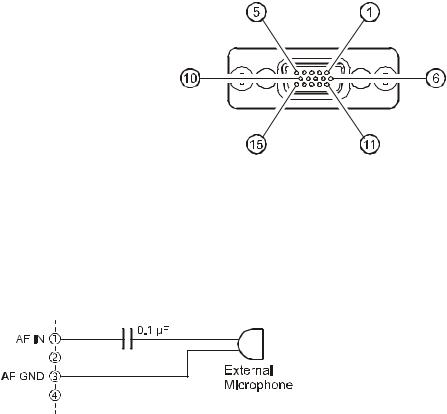
DSUB 15-pin Accessory Connector
Pin 1: AF IN (ANALOG INPUT)
External Microphone Input. Nominal input level is 6 mV at 600-ohm.
When connect the External Microphone to this port, insert a 0.1 µF coupling capacitor between the microphone and this port; as shown illustlation.
Pin 6: EXT PTT
Shorting this port to ground causes the transceiver to be placed in the Transmit mode, while opening the connection to this port returns the transceiver to the Receive mode. Opening voltage is 5 V, closed current approx. 5 mA.
Pin 2: AF OUT (ANALOG OUTPUT)
Low-level receiver output. Peak signal level is 150 mV at 600-ohm.
Pin 3: AF GND
Ground for all logic levels and power supply return.
Pin 4: DC OUT (13.6 V DC OUTPUT)
Switched 13.6V output for supplying power to an accessory.
Pin 5: RSSI (ANALOG OUTPUT)
A DC voltage proportional to the strength of the signal currently being received (Receiver Signal Strength Indicator) is provided on this pin. This low impedance output is gererated by the receiver IF sub-system and bufferd by an internal op-amp. Typical output voltages are 1 V (@No Signal Input) through 2.0 V (@50 dB Signal Input).
Pin 7: TRX
This port is intended for controlling an external TX/ RX switching circuit. When the transceiver is placed in the the Receiver mode, this port is 5 V. When the transceiver is placed in the the Transmit mode, this port reduse to 0 V.
Pin 8: IGN (IGNITION SENSE FEATURE)
The VX-2100/-2200 may be automatically be switched to the STND-BY mode when the vehicle's ignition key is turned on. Maximum current is 20 mA.
Pin 9 - 12: ACC1 - ACC4 (ACCESSORY PORT)
These port features can be programmed via the CE82 programmer. Each port is open collector output which can sink approx. 100 mA when active. Max. output 16V.
When the input is selected, it becomes active between 2V and 16V.
Pin 13:ACC5 (ACCESSORY PORT)
The port 5 is available to set only for Output function, and active logic is the opposite side against the Port 1 ~ 4.
Max.output 5V, closed current approx. 1 mA. (CMOS output)
Pin 14:ACC6 (ACCESSORY PORT)
The port 6 is available to set only for Input function, and active logic is the opposite side against the Port 1 ~ 4.
Max.input 5V. (CMOS input)
Pin 15: GND
Chassis ground
B-1
Note
B-2
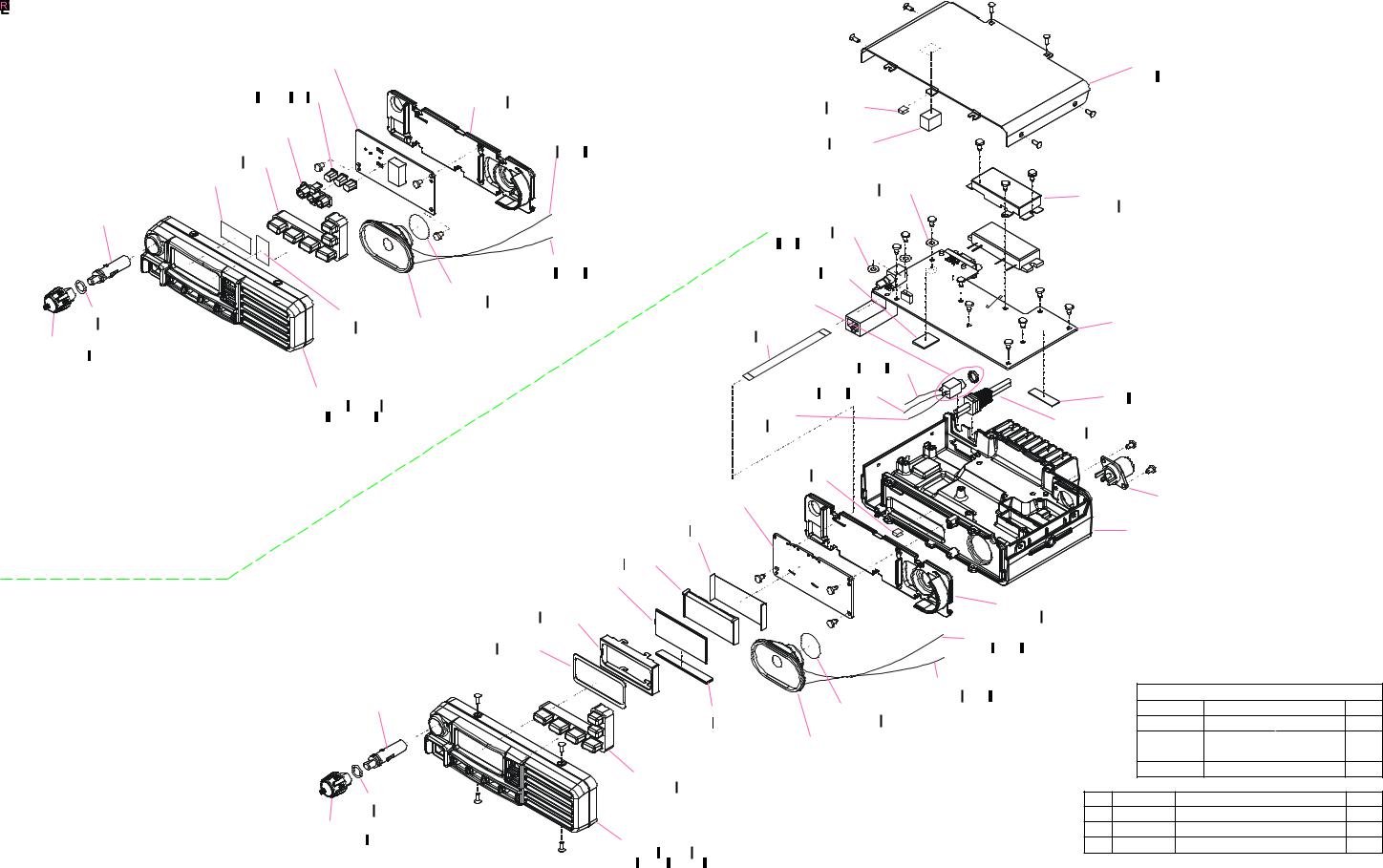
Exploded View & Miscellaneous Parts





Non-designated parts are available only as part of a designated assembly.
|
|
|
|
|
|
|
|
|
|
C-1
Exploded View & Miscellaneous Parts
Note:
C-2
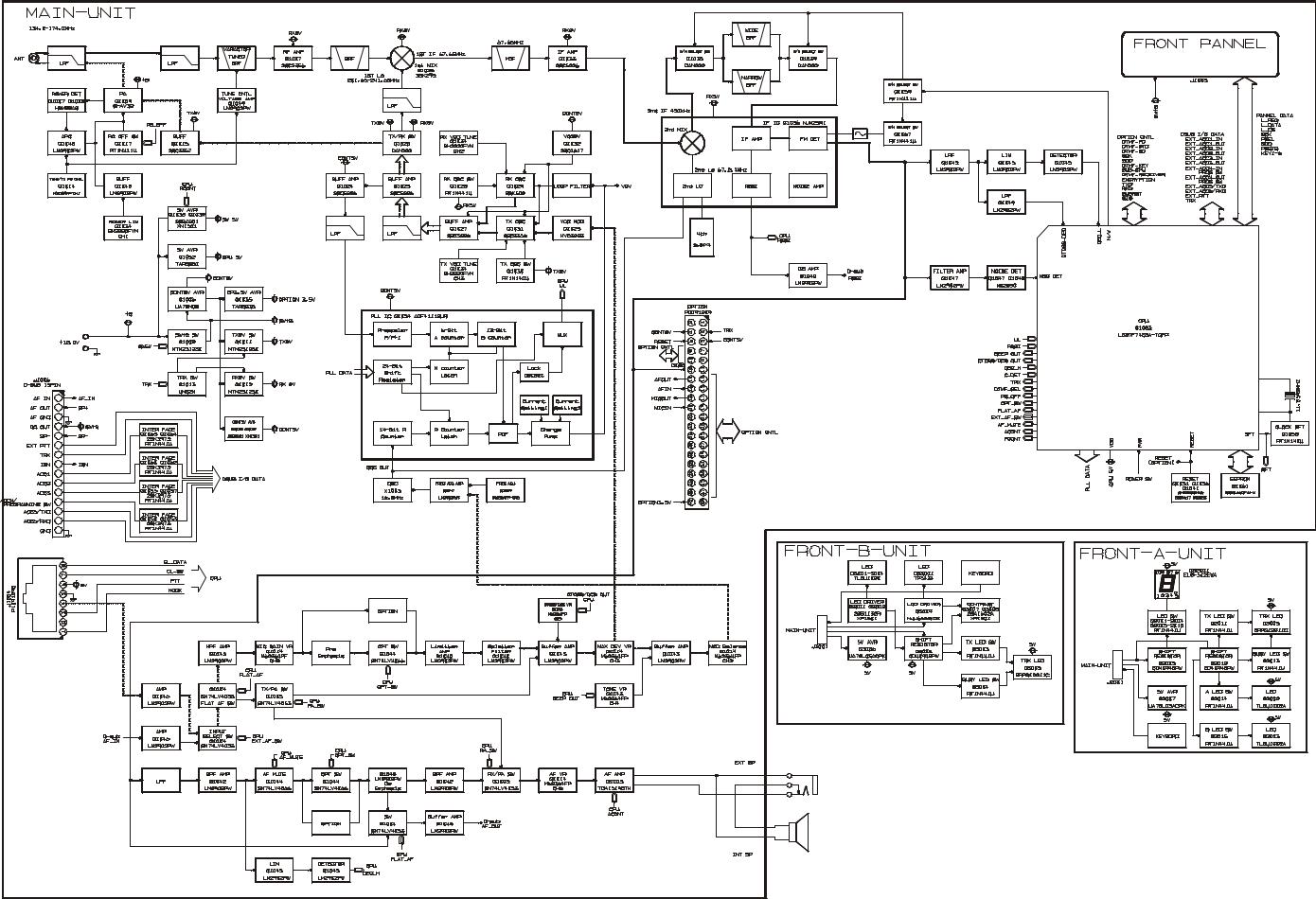
Block Diagram
D-1
Block Diagram
Note:
D-2
1. Circuit Configuration by Frequency
The receiver is a double-conversion superheterodyne with a first intermediate frequency (IF) of 67.65 MHz and a second IF of 450kHz. The incoming signal from the antenna is mixed with the localsignalfromtheVCO/PLLtoproducethefirstIFof50.85MHz. This is then mixed with the 67.2 MHz second local oscillator output to produce the 450 kHz second IF. This is detected to give the demodulated signal.The transmit signal frequencyis generated by the PLL VCO and modulated by the signal from the microphone. It is then amplified and sent to the antenna.
2. Receiver System
2-1.Front-endRFamplifier
The incoming RF signal from the antenna is delivered to the RF Unit and passes through the Low-pass filter which removes undesired frequencies by use of varactor diodes, tuned bandpass filter consisting of diodes D1003 (1SV323), D1004 (1SV323), D1005 (1SV323), D1006 (1SV323) and Coils L1006 and L1009, capacitors C1013, C1016, C1033, and C1039, C1041, C1044.
The passed signal is amplified in Q1007 (2SC3356) and moreover cuts an image frequency with the band pass filter consistingofCoilsL1011,L1013andL1014,L1015andcapacitorsC1003 C1011,C1012,C1016andC1022,C1023,C1027andC1028,C1334, C1141 and comes into the 1st mixer.
2-2. First Mixer
The 1st mixer consists of the Q1025 (3SK293). Buffered outputfrom the VCO is amplified by Q1023 (2SC5226) to provide a purefirst local signal between 201.65 and 241.65 MHz for injection to the first mixer. The output IF signal is entersfrom the mixer to the crystal filter. The IF signal then passesthrough monolithic crystal filters XF1001 (±5.5 kHz BW) to strip away all but the desired signal.
2-3. IFAmplifier
The first IF signal is amplified by Q1033 (2SC5226). The amplifiedfirst IF signal is applied to FM IF subsystem IC Q1036 (NJM2591) which contains the second mixer second local os- cillatorlimiteramplifiernoiseamplifierandS-meteramplifier.The signalfromthe refernce oscillatoris tripled by Q1033(2SC5226), it is mixed with the IF signal and becomes 450 kHz. The second IF then passes through the ceramic filter CF1001 (for wide channels) CF1002 (for narrow channels) to strip away unwanted mixer products which removes amplitude variations in the 450 kHz IF before detection of the speech by the ceramicdiscriminator CD1001.
2-4.Audio amplifier
Detected signal from Q1036 (NJM2591V) is inputted to Q1042 (LM2902PW) and is output through the band pass filter inside Q1042 (LM2902PW). When the optional unit is installed Q1044 (SN74LV4066APW) is turned "OFF" and the AF sig-
Circuit Description
nal from Q1042 (LM2902PW) goes the optional unit. When the optional unit is not installed, Q1042 (LM2902PW) is turned "ON" and the signal goes through Q1004 (SN74LV4053APM). The signal then goes through AF mute switch Q1044
(SN74LV4066APW) de-emphasis part Q1042 (LM2902PW). amplified withAF power amplifier Q1003 (TDA1519CTH) after passing AF volume Q1014 (M62364FP). The output of Q1003 (TDA1519CTH) drives a speaker (either the internal or external speaker).
2-5. Squelch Circuit
There are 13 levels of squelch setting from 0 to 12. The level 0 means open the squelch. The level 1 means the threshold setting level and level 11 means tight squelch. From 2 to 10 is established in the middle of threshold and tight. The bigger figure is nearer the tight setting. The level 12 becomes setting of carrier squelch.
2-5-1. Noise Squelch
The noise squelch circuit is composed of the band pass filter of Q1036 (NJM2591V) noise amplifier Q1047 (LM2902PW) and noise detector D1047, D1048 (both MC2850). When a carrier isn`t received, the noise ingredient which goes out of the demodulator Q1036 (NJM2591V) is amplified in Q1047 (LM2902PW) through the band pass filter Q1036 (NJM2951V) is detected to DC voltage with D1047, D1048 (both MC2850) and is inputted to 15 pin (the A/D port) of the Q1065 (CPU: LC87F5CC8A). When a carrier is received the DC voltage becomes "LOW" because the noise is compressed. When the detected voltage to CPU is "HIGH," the CPU stops AF output with Q1044 (SN74LV4053) "OFF" by making pin 80 low. When the detection voltage is low the CPU makes Q1068 "ON" making pin 80 "H" enabling AF output.
2-5-2. Carrier Squelch
The Pin 14 (A/D port) of Q1065 (CPU: LC87F5CC8A) detects RSSI voltage output from pin 12 of Q1036 (NJM2591V), and controls AF output. The RSSI output voltage changes according to the signal strength of carrier. The stronger signal makes the RSSI voltage higher. The process of the AF signal control is the same as Noise Squelch. The shipping data is adjusted 3dB higher than squelch tight sensitivity.
3. Transmitter System
3-1. MicAmplifier
There are two micrphone inputs, J1004 (front) and J1006 (D- Sub). Each microphone inputs has it's own amplifier. Which micrphone is selected is controlled by the CPU and in addition, the amplified AF signal is selected with Flat-AF selection switch Q1043 (LM2902PW). Mic Gain is adjusted with Mic gain VR Q1014 (M62364PF) through HPF-AMP Q1043 (LM2902PW), and Pre Enphasis and Mic Mute Q1044 (SN74LV4066) are passed at FLAT-AF OFF. And, the option use is selected with
E-1
Circuit Description
OPT selection switch Q1044 (SN74LV4066) by the control from CPU. The selected signal enters maximum deviation adjustment volume Q1014 (M62364FP) after it goes out of Buffer Amp Q1043 (LM2902PW) through limiter and splatter filter of Q1040 (LM2902PW). The adjusted low frequency signal ingredient is amplified by Q1047 (LM2902PW) added modulation terminal of TCXO (X1002) the FM modulation is made by reference oscillator. The high frequency signal ingredient is amplified Q1043 (LM2902PW), and the level is adjusted by volume control Q1014 (M62364FP) to make frequency balance between low frequency. After that, the signal is delievered to the tranmsit carrier by modulator D1023 (HVC383B).
3-2. Drive and Final amplifier
The modulated signal from the VCO Q1031 (2SC3356) is buffered by Q1027 (2SC5226) and amplified by Q1015 (2SC3357). The low-level transmit signal is then applied to the Power Module Q1009 (S-AV32) for final amplification up to 50 watts output power. The transmit signal then passes through a low-pass filter to suppress harmonic spurious radiation before delivery to the antenna.
3-3.Automatic Transmit PowerControl
The output power of Power Module is detected by CM coupler, and is detected by D1008 and D1038 (both HSM88AS) and is inputted to comparator Q1048 (LM2902PW). The comparetor compares two different voltages and makes output power stable by controlling the bias voltage of the power module. There are 3 levels of output power (Hi, Mid and Lo) which is switched by the voltage of Q1014-CH1 (M62364FP).
3-4. PLL Frequency Synthesizer
The frequency synthesizer consists of PLL IC Q1054 (ADF411BRU) VCO, TCXO (X1002)and buffer amplifier. The output frequency from TCXO is 16.8 MHz and the tolerance is ±2.5 ppm (in the temperature range -30 to +60 degrees).
3-4-1. VCO
While the radio is receiving, the RX oscillator Q1029 (2SK508) in the VCO generates a programmed frequency between 201.65 and 241.65 MHz as 1st local signal. While the radio is transmitting the TX oscillator Q1031 (2SC3356) in the VCO generates a frequency between 134 and 174 MHz. The output from oscillator is amplified by buffer amplifier Q1027 (2SC5226) and becomes the output of the VCO. The output from VCO is divided one is amplified by Q1024 (2SC5226) and feed back to pin 6 of the PLL IC Q1054 (TRF3750IP). The other is amplified in Q1023 (2SC5226) and in case of the reception it is put into the mixer as the 1st local signal through D1020 (DAN222) in transmission it is amplified in Q1027 (2SC5226) and more amplified in Q1023 (2SC5226) through D1022 (DA222) and it is put the input terminal of the Power Module Q1009 (S-AV32).
3-4-2. VCV CNTL
Tuning voltage (VCV) of the VCO expands the lock range of VCO by controlling the of varactor diode voltage and the control voltage from PLL IC Q1054 (ADF4111BRU). Control voltage is added to the varactor diode after converted to D/A converter Q1029 (M62364FP).
3-4-3. PLL
The PLL IC Q1054 (ADF4111BRU) consists of reference divider, main divider, phase detector, charge pumps and Pulse Swallow Frequency Synthesis. The reference frequency from TCXO is inputted to pin 8 of PLL IC Q1054 (ADF4111BRU) and is divided by reference divider. This IC is decimal point dividing PLL IC Q1054 (ADF4111BRU) and the dividing ratio becomes 1/8 of usual PLL frequency step. Therefore, the output of reference divider is 8 times of frequencies of the channel step. For example when the channel stepping is 5 kHz, the output of reference divider becomes 40 kHz. On the other hand, inputted feed back signal to pin 6 of PLLIC Q1054 (ADF4111BRU) from VCO is divided with the dividing ratio which becomes same frequency as the output of reference divider. These two signals are compared by phase detector, a phase pulse is generated. The phase difference pulse and the pulse from fractional accumulator pass through the charge pumps and LPF. This becomes the DC voltage (VCV) to control the VCO. The oscillation frequency of VCO is locked by the control of this DC voltage. The PLL serial data from CPU Q1065 (CPU: LC87F5CC8A) is sent with three lines of SDO (pin 12), SCK (pin 11) and PSTB (pin 13). The lock condition of PLL is output from the UL (pin 14) terminal and UL becomes "H" at the time of the lock condition and becomes "L" at the time of the unlocked condition. The CPU Q1065 (CPU: LC87F5CC8A) always watches over the UL condition, and when it becomes "L" unlocked condition, the CPU Q1065 (CPU: LC87F5CC8A) prohibits transmitting and receiving.
E-2
Introduction
The VX-2100/-2200 series has been aligned at the factory for the specified performance across the entire frequency range specified. Realignment should therefore not be necessary except in the event of a component failure. All component replacement and service should be performed only by an authorized Vertex Standard representative, or the warranty policy may be voided.
The following procedures cover the sometimes critical and tedious adjustments that are not normally required once the transceiver has left the factory. However, if damage occurs and some parts are replaced, realignment may be required. If a sudden problem occurs during normal operation, it is likely due to component failure; realignment should not be done until after the faulty component has been replaced.
We recommend that servicing be performed only by authorized Vertex Standard service technicians who are experienced with the circuitry and fully equipped for repair and alignment. Therefore, if a fault is suspected, contact the dealer from whom the transceiver was purchased for instructions regarding repair. Authorized Vertex Standard service technicians realign all circuits and make complete performance checks to ensure compliance with factory specifications after replacing any faulty components. Those who do undertake any of the following alignments are cautioned to proceed at their own risk. Problems caused by unauthorized attempts at realignment are not covered by the warranty policy. Also, Vertex Standard must reserve the right to change circuits and alignment procedures in the interest of improved performance, without notifying owners. Under no circumstances should any alignment be attempted unless the normal function and operation of the transceiver are clearly understood, the cause of the malfunction has been clearly pinpointed and any faulty components replaced, and the need for realignment determined to be absolutely necessary. The following test equipment (and thorough familiarity with its correct use) is necessary for complete realignment. Correction of problems caused by misalignment resulting from use of improper test equipment is not covered under the warranty policy. While most steps do not require all of the equipment listed, the interactions of some adjustments may require that more complex adjustments be performed afterwards. Do not attempt to perform only a single step unless it is clearly isolated electrically from all other steps. Have all test equipment ready before beginning, and follow all of the steps in a section in the order presented.
Alignment
Required Test Equipment
Radio Tester with calibrated output level at 200 MHz
In-line Wattmeter with 5% accuracy at 200 MHz
50-ohm, 50-W RF Dummy Load
Regulated DC Power Supply (standard 13.6V DC, 15A)
Frequency Counter: ±0.2 ppm accuracy at 200 MHz
AF Signal Generator
AC Voltmeter
DC Voltmeter
VHF Sampling Coupler
Microsoft® Windows® 95 or later operating system
Vertex Standard VPL-1 Connection Cable and CE82 Alignment program
Alignment Preparation & Precautions
A 50-ohm RF Dummy load and in-line wattmeter must be connected to the main antenna jack in all procedures that call for transmission, except where specified otherwise. Correct alignment is not possible with an antenna.
Beacuse of the BTL (Bridged TransLess) Amplifier circuit used in the VX-2200/-2100, do not connect eather side of the speaker leads to chassis "ground."
After completing one step, read the following step to determine whether the same test equipment will be required. If not, remove the test equipment (except dummy load and wattmeter, if connected) before proceeding.
Correct alignment requires that the ambient temperature be the same as that of the transceiver and test equipment, and that this temperature be held constant between 20 °C and 30 °C (68 °F ~ 86 °F). When the transceiver is brought into the shop from hot or cold air, it should be allowed time to come to room temperature before alignment.
Whenever possible, alignments should be made with oscillator shields and circuit boards firmly affixed in place. Also, the test equipment must be thoroughly warmed up before beginning.
Note: Signal levels in dB referred to in this procedure are based on 0 dBµ EMF = 1.0 µV.
F-1
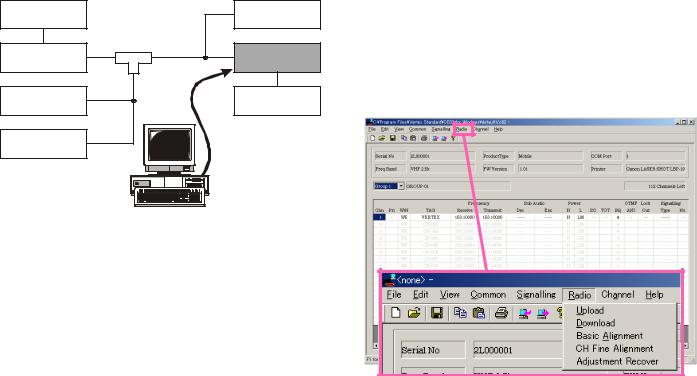
Alignment
Test Setup
Setup the test equipment as shown for transceiver alignment, apply 13.6V DC power to the transceiver. Refer to the drawings above for Alignment Points.
50-ohm |
|
|
RF |
Dummy Load |
|
Signal Generator |
|
|
RF Sampling |
|
|
Inline |
Coupler |
ANT |
|
|
Transceiver |
||
Wattmeter |
|
|
|
|
|
|
|
|
|
MIC |
DC INPUT |
Deviation Meter |
|
Power Supply |
|
|
|
13.6 VDC |
|
|
|
|
|
Frequency |
|
VPL-1 |
|
|
Connection Cable |
||
Counter |
|
|
|
|
|
COM Port |
|
The Alignment Tool Outline
Installation the tool
Install the CE82 (Clone Editor) to your PC.
The re-alignment for VX-2200/-2100 series may use the "Alignment" menu of CE82.
Action of the switches
When the transceiver is in alignment mode, the action of PTT and KEY is ignored. All of the action is remote controlled by PC.
Basic Alignment Mode
The Basic Alignment mode allows you to align the entire radio. The value of each parameter can be changed to the desired position by use of the “ ” / “ ” and up/down arrow keys, along with direct number input and dragging of the PC mouse.
To enter the Basic Alignment Mode, select “Basic Alignment” in the main “Radio” menu. It will start to “Upload” the written personalized data from the radio. Pressing the “OK” button will then start the Basic Alignment Mode.
Note: when all items are to be aligned, it is strongly recommended to align them according to following sequence. When the item is selected with TAB key, and the F1 key is pushed, the “Help” file is displayed.
Detailed information for each step may be found in the “Help” file within CE82 (Clone Editor).
1.RX VCO Tune Voltage (RX VCO)
2.TX VCO Tune Voltage (TX VCO)
3.PLL Reference Frequency (Frequency)
4.RX Sensitivity (RX Tune)
5.Squelch (SQL)
6.TX Power
7.Maximum Deviation <Wide> / <Narrow>
8.Sub Audio Deviation <CTCSS> / <DCS>
9.Sequential Tone Deviation
F-2
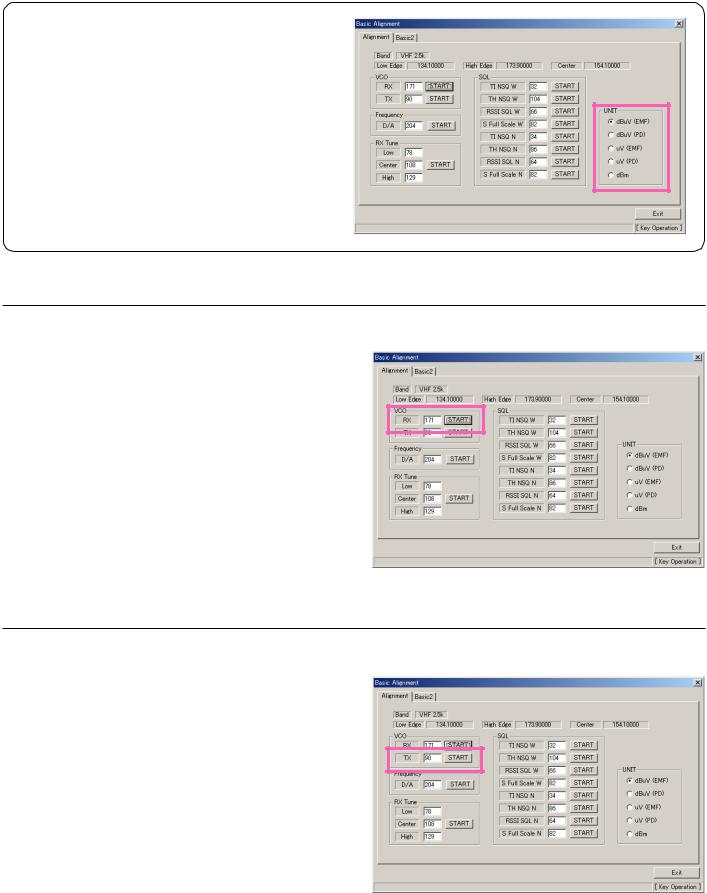
Alignment
Unit
During alignment, the values of dBµV or µV (EMF or
PD) can be selected or dBm.
1. RX VCO Tune Voltage (RX VCO)
This parameter is to align the "Tune Voltage" of RX VCO. This alignment will be done automatically between the radio and PC.
1.Press the "Start" button on the "Basic Alignment" window to open the RX VCO Adjustment window.
2.Press the "Start" button to start the alignment then the "OK" and "Cancel" buttons are inhibited during the alignment.
3.The aligned value will appear and the "OK", "Cancel" buttons come alive when auto-alignment is finished.
4.Press the "OK" button on the window, the value of the alignment for RX VCO will be saved in the radio.
2. TX VCO Tune Voltage (TX VCO)
This parameter is to align the "Tune Voltage" of TX VCO. This alignment will be done automatically between the radio and PC.
1.Press the "Start" button on the "Basic Alignment" window to open the TX VCO Adjustment window.
2.Press the "Start" button to start the alignment then the "OK" and "Cancel" buttons are inhibited during the alignment.
3.The aligned value will appear and the "OK", "Cancel" buttons come alive when auto-alignment is finished.
4.Press the "OK" button on the window, the value of the alignment for TX VCO will be saved in the radio.
F-3
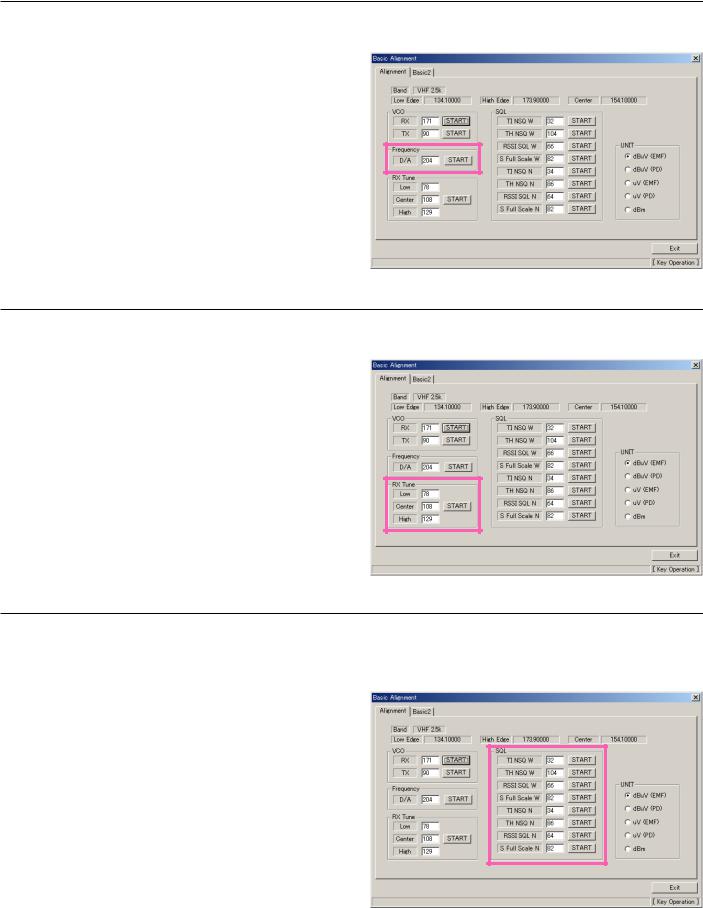
Alignment
3. PLL Reference Frequency (Frequency)
This parameter is to align the reference frequency for PLL. The "TX VCO Tune Voltage" alignment must be done before this alignment is going to start.
1.Press the "Start" button to start the alignment then the radio will transmit on the center frequency. It will appear the Frequency Alignment window.
2.Set the value to get desired frequency by left/right arrow key, drag the slide bar by mouse or direct number input.
3.Press the "OK" button on the alignment window to save the re-aligned value, the alignment of the PLL Reference Frequency is accomplished.
4.RX Sensitivity (RX Tune)
This parameter is to align the RX BPF (Band Pass Filter) for Rx sensitivity. It must be done both alignments of the "RX VCO Tune Voltage" and "PLL Reference Frequency" before this alignment is going to start.
1.Press the "Start" button to start the alignment.
2.Set the Signal Generator according to the indication, then press "OK".
3.Repeat the procedure no.2 until the 3point alignment is finished.
4.It will show the result of 3 points alignment and press "OK" then the confirmation window will open.
5.Press "OK" to finish the RX Sensitivity alignment and save the data.
5. Squelch (SQL)
This parameter is to align the SQL (Squelch) Sensitivity. The "RX VCO Tune Voltage", "PLL Reference Frequency" and "RX Sensitivity (RX Tune)" must be done before this alignment is started.
There are several alignments as follows in the Squelch Sensitivity.
Noise SQL Tight <Wide> (TH NSQ W)
The Alignment for the Noise SQL Tight level at Wide (5k/ 4k).
Noise SQL Threshold <Wide> (TH NSQ W)
The Alignment for the Noise SQL Threshold level at Wide (5k/4k).
RSSI SQL Level 11 <Wide> (RSSI SQL W)
The Alignment for the "level 11" of the RSSI SQL level at
Wide (5k/4k).
F-4
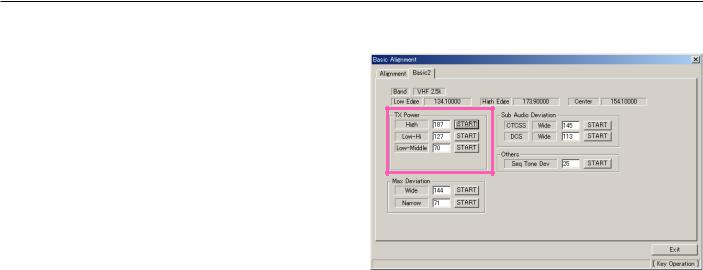
Alignment
RSSI SQL Full Scale <Wide> (S Full Scale W)
The Alignment for the RSSI Full Scale level at Wide (5k/ 4k).
Noise SQL Tight <Narrow> (TI NSQ N)
The Alignment for the Noise SQL Tight level at Narrow (2.5k).
Noise SQL Threshold < Narrow > (TH NSQ N)
The Alignment for the Noise SQL Threshold level at Narrow (2.5k).
RSSI SQL Level 11 < Narrow > (RSSI SQL N)
The Alignment for the "level 11" of the RSSI SQL level at
Narrow (2.5k).
RSSI SQL Full Scale < Narrow > (S Full Scale N)
The Alignment for the RSSI Full Scale levle at Narrow (2.5k).
The procedure for all the alignment is as follows.
1.Press the “Start” button to start the alignment.
2.Set the signal generator according to the level indicated, then press "OK".
3.Press the “OK” button after finish the alignment, then the data will be saved and the alignment is accomplished.
6. TX Power
Open the "Basic2" window, this parameter is to align the Transmit Output (Hi/Low) Power. The factory default is as followings.
High High power version: 50W
Low-High High power version: 25W
Low-Mid High power version: 10W
The procedure for the alignments of the TX Power is followings.
1.Press the "Start" button to start the alignment then the radio will transmit on the center frequency. The TX Power Alignment window will open on the PC.
2.Set the value to get desired output power by left/right arrow key, drag the slide bar by mouse or direct number input.
3.Press the "OK" button on the alignment window to save the re-aligned value, the alignment of the TX POWER is accomplished.
F-5
